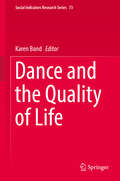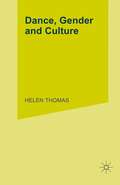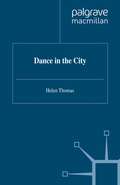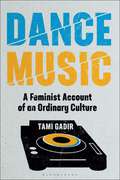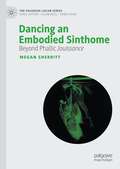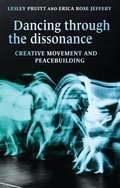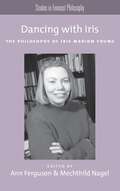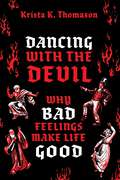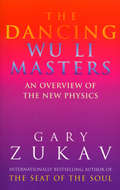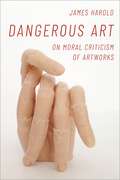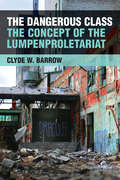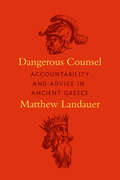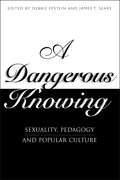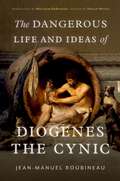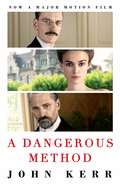- Table View
- List View
Dance and the Quality of Life (Social Indicators Research Series #73)
by Karen BondThis is the first volume devoted to the topic of dance and quality of life. Thirty-one chapters illuminate dance in relation to singular and overlapping themes of nature, philosophy, spirituality, religion, life span, learning, love, family, teaching, creativity, ability, socio-cultural identity, politics and change, sex and gender, wellbeing, and more. With contributions from a multi-generational group of artists, community workers, educators, philosophers, researchers, students and health professionals, this volume presents a thoughtful, expansive-yet-focused, and nuanced discussion of dance’s contribution to human life. The volume will interest dance specialists, quality of life researchers, and anyone interested in exploring dance’s contribution to quality of living and being.
Dance, Gender and Culture
by Helen Thomas'...full credit to Thomas and Macmillan for embarking on such a worthwhile venture - Dance Research I have already found the Thomas edition of enormous value in teaching both undergraduates and postgraduates, from the perspectives of dance anthropology, ethnography and theatre dance analysis - Theresa Buckland, Department of Dance Studies, University of Surrey This unique collection of papers, written specially for this volume, explores the aspects of the ways in which dance and gender intersect in a variety of cultural contexts, from social and disco dance to performance dance, to the Hollywood musical and dances from different cultures. The contributors come from a broad range of disciplines, such as cultural studies, anthropology, sociology, dance studies, film studies, and journalism. They bring to the book a wide body of ideas and approaches, including feminism, psychoanalysis, ethnography and subcultural theory. List of Plates - Preface to the 1995 Reprint - Notes on the Contributors - Introduction - PART 1: CULTURAL STUDIES - Dance, Gender and Culture; T.Polhumus - Dancing in the Dark: Rationalism and the Neglect of Social Dance; A.Ward - Ballet, Gender and Cultural Power; C.J.Novack - 'I Seem to Find the Happiness I Seek': Heterosexuality and Dance in the Musical; R.Dyer - PART 2: ETHNOGRAPHY - An-Other Voice: Young Women Dancing and Talking; H.Thomas - Gender Interchangeability among the Tiwi; A.Grau - 'Saturday Night Fever': An Ethnography of Disco Dancing; D.Walsh - Classical Indian Dance and Women's Status; J.L.Hanna - PART 3: THEORY/CRITICISM - Dance, Feminism and the Critique of the Visual; R.Copeland - 'You put your left foot in, then you shake it all about ...': Excursions and Incursions into Feminism and Bausch's Tanztheater; A.Sanchez-Colberg - 'She might pirouette on a daisy and it would not bend': Images of Femininity and Dance Appreciation; L-A.Sayers - Still Dancing Downwards and Talking Back; Z.Oyortey - The Anxiety of Dance Performance; V.Rimmer - Index
Dance in the City
by Helen ThomasThis exciting new and original collection locates dance within the spectrum of urban life in late modernity, through a range of theoretical perspectives. It highlights a diversity of dance forms and styles that can be witnessed in and around contemporary urban spaces: from dance halls to raves and the club striptease; from set dancing to ballroom dancing, to hip hop and swing, and to ice dance shows; from the ballet class, to fitness aerobics; and 'art' dance which situates itself in a dynamic relation to the city.
Dance Music: A Feminist Account of an Ordinary Culture (Alternate Takes: Critical Responses to Popular Music)
by Dr Tami GadirFor some people, at some times, in some places, on some drugs, dance music can be a gateway to transformative, even transcendent experiences. With the help of skilled DJs, dancers can reach euphoric states, discard their egos, and feel social barriers dissolve. Dance floors can be sites of openness, subversion, and even small-scale acts of political resistance. At a minimum, dance music lightens the burdens of contemporary life. At its best, dance music offers glimpses of better worlds. Yet even where dance music communities are built on principles of resistance and liberation, they nevertheless share the grittier realities of the rest of the world. Dance Music makes the case that dance music is ordinary and that something exceeding the social and spatiotemporal bounds of the dance floor is required for the transformative promise of dance music to be realized.
Dance Music: A Feminist Account of an Ordinary Culture (Alternate Takes: Critical Responses to Popular Music)
by Dr Tami GadirFor some people, at some times, in some places, on some drugs, dance music can be a gateway to transformative, even transcendent experiences. With the help of skilled DJs, dancers can reach euphoric states, discard their egos, and feel social barriers dissolve. Dance floors can be sites of openness, subversion, and even small-scale acts of political resistance. At a minimum, dance music lightens the burdens of contemporary life. At its best, dance music offers glimpses of better worlds. Yet even where dance music communities are built on principles of resistance and liberation, they nevertheless share the grittier realities of the rest of the world. Dance Music makes the case that dance music is ordinary and that something exceeding the social and spatiotemporal bounds of the dance floor is required for the transformative promise of dance music to be realized.
Dancing an Embodied Sinthome: Beyond Phallic Jouissance (The Palgrave Lacan Series)
by Megan SherrittThis book provides the first in-depth analysis of Lacanian psychoanalytic theory and the art of dance and explores what each practice can offer the other. It takes as its starting point Jacques Lacan’s assertion that James Joyce’s literary works helped him create what Lacan terms a sinthome, thereby preventing psychosis. That is, Joyce’s use of written language helped him maintain a “normal” existence despite showing tendencies towards psychosis. Here it is proposed that writing was only the method through which Joyce worked but that the key element in his sinthome was play, specifically the play of the Lacanian real.The book moves on to consider how dance operates similarly to Joyce’s writing and details the components of Joyce’s sinthome, not as a product that keeps him sane, but as an interminable process for coping with the (Lacanian) real. The author contends that Joyce goes beyond words and meaning, using language’s metre, tone, rhythm, and cadence to play with the real, mirroring his experience of it and confining it to his works, creating order in the chaos of his mind. The art of dance is shown to be a process that likewise allows one to play with the real. However, it is emphasized that dance goes further: it also teaches someone how to play if one doesn't already know how. This book offers a compelling analysis that sheds new light on the fields of psychoanalysis and dance and looks to what this can tell us about—and the possibilities for—both practices, concluding that psychoanalysis and dance both offer processes that open possibilities that might otherwise seem impossible. This original analysis will be of particular interest to those working in the fields of psychoanalysis, aesthetics, psychoanalytic theory, critical theory, art therapy, and dance studies.
Dancing through the dissonance: Creative movement and peacebuilding
by Lesley Pruitt Erica Rose JeffreyConflicts are increasingly recognised as situated in local contexts with culturally specific elements playing important roles. At the same time, conflicts reflect and contribute to global dynamics. Seeking peace within this complexity requires curious, creative and critical approaches that can account for politics. But how can peacebuilders account for unique local settings while also recognising multiple and diverse perspectives within and between them? Reflecting on this question, Dancing through the dissonance explores the relationship between peacebuilding and dance in pluralist societies, examining the practice of dance-focused peacebuilding programmes in Colombia, the Philippines and the United States. Incorporating participant voices, critical political analysis and reflections on dance practice, the authors reveal the implications and nuances of arts-based peace initiatives. This book offers a unique insight into the application, practice and analysis of dance-focused peacebuilding programmes, building on a critical understanding of the politics of integrating dance into peacebuilding and the ways in which these programmes fit into global debates around peace and conflict. As the global community continues to seek inclusive pathways to peace that improve upon, supplement, or replace existing dominant approaches, this book provides a valuable in-depth analysis and recommendations for arts-based peacebuilding approaches.
Dancing through the dissonance: Creative movement and peacebuilding
by Lesley Pruitt Erica Rose JeffreyConflicts are increasingly recognised as situated in local contexts with culturally specific elements playing important roles. At the same time, conflicts reflect and contribute to global dynamics. Seeking peace within this complexity requires curious, creative and critical approaches that can account for politics.But how can peacebuilders account for unique local settings while also recognising multiple and diverse perspectives within and between them? Reflecting on this question, Dancing through the dissonance explores the relationship between peacebuilding and dance in pluralist societies, examining the practice of dance-focused peacebuilding programmes in Colombia, the Philippines and the United States. Incorporating participant voices, critical political analysis and reflections on dance practice, the authors reveal the implications and nuances of arts-based peace initiatives.This book offers a unique insight into the application, practice and analysis of dance-focused peacebuilding programmes, building on a critical understanding of the politics of integrating dance into peacebuilding and the ways in which these programmes fit into global debates around peace and conflict.As the global community continues to seek inclusive pathways to peace that improve upon, supplement, or replace existing dominant approaches, this book provides a valuable in-depth analysis and recommendations for arts-based peacebuilding approaches.
Dancing with Iris: The Philosophy of Iris Marion Young (Studies in Feminist Philosophy)
by Ann Ferguson Mechthild NagelIris Marion Young was a world-renowned feminist moral and political philosopher whose many books and articles spanned more than three decades. She explored issues of social justice and oppression theory, the phenomenology of women's bodies, deliberative democracy and questions of terrorism, violence, international law and the role of the national security state. Her works have been of great interest to those both in the analytic and Continental philosophical tradition, and her roots range from critical theory (Habermas and Marcuse), and phenomenology (Beauvoir and Merleau Ponty) to poststructural psychoanalytic feminism (Kristeva and Ingaray). This anthology of writings aims to carry on the fruitful lines of thought she created and contains works by both well-known and younger authors who explore and engage critically with aspects of her work. The essays include personal remembrances as well as a last interview with Young about her work. The essays are organized into topic areas that are of interest to students in advanced undergraduate and graduate courses in ethics, feminist theory, and political philosophy.
Dancing with the Devil: Why Bad Feelings Make Life Good
by Krista K. ThomasonJust as a garden needs worms, we need bad feelings.... We tend to think about bad feelings--feelings like anger, envy, spite, and contempt--as the weeds in life's garden. You may not be able to get rid of them completely, but you're supposed to battle them as best you can. The best garden is one with no weeds. The best life is one with no bad feelings. But this isn't quite right, according to philosopher Krista K. Thomason. Bad feelings are the worms, not the weeds. They're just below the surface, and we like to pretend they aren't there, but they serve an important purpose. Worms are just as much a part of the garden as the flowers, and their presence means your garden is thriving. Gardens aren't better off without their worms, and neither are we. The trick is learning how to enjoy our gardens, worms and all. Thomason draws on insights from the history of philosophy to show what we've gotten wrong about bad feelings and to show readers how we can live better with them. There is nothing wrong with negative emotions per se. Their bad reputation is undeserved. Negative emotions are expressions of self-love--not egoism or selfishness, but the felt attachment to ourselves and to our lives. We feel negative emotions because our lives matter to us. After explaining this, Thomason helps us look at individual bad feelings: anger, envy and jealousy, spite and Schadenfreude, and contempt. As she demonstrates in this tour of negative emotions, these feelings are valuable parts of our attachment to our lives. We don't have to battle negative emotions or "channel" them into something productive. Bad feelings aren't obstacles to a good life; they are part of what makes life meaningful.
Dancing with the Devil: Why Bad Feelings Make Life Good
by Krista K. ThomasonJust as a garden needs worms, we need bad feelings.... We tend to think about bad feelings--feelings like anger, envy, spite, and contempt--as the weeds in life's garden. You may not be able to get rid of them completely, but you're supposed to battle them as best you can. The best garden is one with no weeds. The best life is one with no bad feelings. But this isn't quite right, according to philosopher Krista K. Thomason. Bad feelings are the worms, not the weeds. They're just below the surface, and we like to pretend they aren't there, but they serve an important purpose. Worms are just as much a part of the garden as the flowers, and their presence means your garden is thriving. Gardens aren't better off without their worms, and neither are we. The trick is learning how to enjoy our gardens, worms and all. Thomason draws on insights from the history of philosophy to show what we've gotten wrong about bad feelings and to show readers how we can live better with them. There is nothing wrong with negative emotions per se. Their bad reputation is undeserved. Negative emotions are expressions of self-love--not egoism or selfishness, but the felt attachment to ourselves and to our lives. We feel negative emotions because our lives matter to us. After explaining this, Thomason helps us look at individual bad feelings: anger, envy and jealousy, spite and Schadenfreude, and contempt. As she demonstrates in this tour of negative emotions, these feelings are valuable parts of our attachment to our lives. We don't have to battle negative emotions or "channel" them into something productive. Bad feelings aren't obstacles to a good life; they are part of what makes life meaningful.
The Dancing Wu Li Masters: An Overview of the New Physics
by Gary ZukavThis is an account of the essential aspects of the new physics for those with little or no knowledge of mathematics or science. It describes current theories of quantum mechanics, Einstein's special and general theories of relativity and other speculations, alluding throughout to parallels with modern psychology and metaphorical abstractions to Buddhism and Taoism. The author has also written "The Seat of the Soul".
Dangerous Art: On Moral Criticisms of Artwork (Thinking Art)
by James HaroldDangerous Art takes up the problem of judging works of art using moral standards. When we think that a work is racist, or morally dangerous, what do we mean? James Harold approaches the topic from two angles. First, he takes up the moral question on its own. What could it mean to say that a work of art (rather than, say, a human being) is immoral? He then steps back and examines how moral evaluation fits into the larger task of evaluating artworks. If an artwork is immoral, what does that tell us about how to value the artwork? By tackling the issue from both sides, Harold demonstrates how many of the reasons previously given for thinking that works of art are immoral do not stand up to careful scrutiny. While many philosophers of art have simply assumed that artworks can be evaluated morally and proceeded as though such assessments were unproblematic, Harold highlights the complexities and difficulties inherent in such evaluations. He argues that even when works of art are rightly condemned from a moral point of view, the relationship between that moral flaw and their value as artworks is complex. He instead defends a moderate, skeptic version of autonomism between morality and aesthetics. Employing figures and ideas from ancient Greece, classical China, and the Harlem Renaissance, as well as William Styron's novel The Confessions of Nat Turner, he argues that we cannot judge artworks in the same way that we judge people on moral grounds. In this sense, we can judge an artwork to be both wicked and beautiful; nothing requires us to judge an artwork more or less valuable aesthetically just because we judge it to be morally bad or good. Taking up complex issues at the intersection of art and ethics, Dangerous Art will appeal to philosophers and students interested in art, aesthetics, moral philosophy, and philosophy of mind.
Dangerous Art: On Moral Criticisms of Artwork (Thinking Art)
by James HaroldDangerous Art takes up the problem of judging works of art using moral standards. When we think that a work is racist, or morally dangerous, what do we mean? James Harold approaches the topic from two angles. First, he takes up the moral question on its own. What could it mean to say that a work of art (rather than, say, a human being) is immoral? He then steps back and examines how moral evaluation fits into the larger task of evaluating artworks. If an artwork is immoral, what does that tell us about how to value the artwork? By tackling the issue from both sides, Harold demonstrates how many of the reasons previously given for thinking that works of art are immoral do not stand up to careful scrutiny. While many philosophers of art have simply assumed that artworks can be evaluated morally and proceeded as though such assessments were unproblematic, Harold highlights the complexities and difficulties inherent in such evaluations. He argues that even when works of art are rightly condemned from a moral point of view, the relationship between that moral flaw and their value as artworks is complex. He instead defends a moderate, skeptic version of autonomism between morality and aesthetics. Employing figures and ideas from ancient Greece, classical China, and the Harlem Renaissance, as well as William Styron's novel The Confessions of Nat Turner, he argues that we cannot judge artworks in the same way that we judge people on moral grounds. In this sense, we can judge an artwork to be both wicked and beautiful; nothing requires us to judge an artwork more or less valuable aesthetically just because we judge it to be morally bad or good. Taking up complex issues at the intersection of art and ethics, Dangerous Art will appeal to philosophers and students interested in art, aesthetics, moral philosophy, and philosophy of mind.
The Dangerous Class: The Concept of the Lumpenproletariat
by Clyde BarrowMarx and Engels’ concept of the “lumpenproletariat,” or underclass (an anglicized, politically neutral term), appears in The Communist Manifesto and other writings. It refers to “the dangerous class, the social scum, that passively rotting mass thrown off by the lowest layers of old society,” whose lowly status made its residents potential tools of the capitalists against the working class. Surprisingly, no one has made a substantial study of the lumpenproletariat in Marxist thought until now. Clyde Barrow argues that recent discussions about the downward spiral of the American white working class (“its main problem is that it is not working”) have reactivated the concept of the lumpenproletariat, despite long held belief that it is a term so ill-defined as not to be theoretical. Using techniques from etymology, lexicology, and translation, Barrow brings analytical coherence to the concept of the lumpenproletariat, revealing it to be an inherent component of Marx and Engels’ analysis of the historical origins of capitalism. However, a proletariat that is destined to decay into an underclass may pose insurmountable obstacles to a theory of revolutionary agency in post-industrial capitalism. Barrow thus updates historical discussions of the lumpenproletariat in the context of contemporary American politics and suggests that all post-industrial capitalist societies now confront the choice between communism and dystopia.
Dangerous Counsel: Accountability and Advice in Ancient Greece
by Matthew LandauerWe often talk loosely of the “tyranny of the majority” as a threat to the workings of democracy. But, in ancient Greece, the analogy of demos and tyrant was no mere metaphor, nor a simple reflection of elite prejudice. Instead, it highlighted an important structural feature of Athenian democracy. Like the tyrant, the Athenian demos was an unaccountable political actor with the power to hold its subordinates to account. And like the tyrant, the demos could be dangerous to counsel since the orator speaking before the assembled demos was accountable for the advice he gave. With Dangerous Counsel, Matthew Landauer analyzes the sometimes ferocious and unpredictable politics of accountability in ancient Greece and offers novel readings of ancient history, philosophy, rhetoric, and drama. In comparing the demos to a tyrant, thinkers such as Herodotus, Plato, Isocrates, and Aristophanes were attempting to work out a theory of the badness of unaccountable power; to understand the basic logic of accountability and why it is difficult to get right; and to explore the ways in which political discourse is profoundly shaped by institutions and power relationships. In the process they created strikingly portable theories of counsel and accountability that traveled across political regime types and remain relevant to our contemporary political dilemmas.
Dangerous Counsel: Accountability and Advice in Ancient Greece
by Matthew LandauerWe often talk loosely of the “tyranny of the majority” as a threat to the workings of democracy. But, in ancient Greece, the analogy of demos and tyrant was no mere metaphor, nor a simple reflection of elite prejudice. Instead, it highlighted an important structural feature of Athenian democracy. Like the tyrant, the Athenian demos was an unaccountable political actor with the power to hold its subordinates to account. And like the tyrant, the demos could be dangerous to counsel since the orator speaking before the assembled demos was accountable for the advice he gave. With Dangerous Counsel, Matthew Landauer analyzes the sometimes ferocious and unpredictable politics of accountability in ancient Greece and offers novel readings of ancient history, philosophy, rhetoric, and drama. In comparing the demos to a tyrant, thinkers such as Herodotus, Plato, Isocrates, and Aristophanes were attempting to work out a theory of the badness of unaccountable power; to understand the basic logic of accountability and why it is difficult to get right; and to explore the ways in which political discourse is profoundly shaped by institutions and power relationships. In the process they created strikingly portable theories of counsel and accountability that traveled across political regime types and remain relevant to our contemporary political dilemmas.
Dangerous Counsel: Accountability and Advice in Ancient Greece
by Matthew LandauerWe often talk loosely of the “tyranny of the majority” as a threat to the workings of democracy. But, in ancient Greece, the analogy of demos and tyrant was no mere metaphor, nor a simple reflection of elite prejudice. Instead, it highlighted an important structural feature of Athenian democracy. Like the tyrant, the Athenian demos was an unaccountable political actor with the power to hold its subordinates to account. And like the tyrant, the demos could be dangerous to counsel since the orator speaking before the assembled demos was accountable for the advice he gave. With Dangerous Counsel, Matthew Landauer analyzes the sometimes ferocious and unpredictable politics of accountability in ancient Greece and offers novel readings of ancient history, philosophy, rhetoric, and drama. In comparing the demos to a tyrant, thinkers such as Herodotus, Plato, Isocrates, and Aristophanes were attempting to work out a theory of the badness of unaccountable power; to understand the basic logic of accountability and why it is difficult to get right; and to explore the ways in which political discourse is profoundly shaped by institutions and power relationships. In the process they created strikingly portable theories of counsel and accountability that traveled across political regime types and remain relevant to our contemporary political dilemmas.
Dangerous Counsel: Accountability and Advice in Ancient Greece
by Matthew LandauerWe often talk loosely of the “tyranny of the majority” as a threat to the workings of democracy. But, in ancient Greece, the analogy of demos and tyrant was no mere metaphor, nor a simple reflection of elite prejudice. Instead, it highlighted an important structural feature of Athenian democracy. Like the tyrant, the Athenian demos was an unaccountable political actor with the power to hold its subordinates to account. And like the tyrant, the demos could be dangerous to counsel since the orator speaking before the assembled demos was accountable for the advice he gave. With Dangerous Counsel, Matthew Landauer analyzes the sometimes ferocious and unpredictable politics of accountability in ancient Greece and offers novel readings of ancient history, philosophy, rhetoric, and drama. In comparing the demos to a tyrant, thinkers such as Herodotus, Plato, Isocrates, and Aristophanes were attempting to work out a theory of the badness of unaccountable power; to understand the basic logic of accountability and why it is difficult to get right; and to explore the ways in which political discourse is profoundly shaped by institutions and power relationships. In the process they created strikingly portable theories of counsel and accountability that traveled across political regime types and remain relevant to our contemporary political dilemmas.
Dangerous Counsel: Accountability and Advice in Ancient Greece
by Matthew LandauerWe often talk loosely of the “tyranny of the majority” as a threat to the workings of democracy. But, in ancient Greece, the analogy of demos and tyrant was no mere metaphor, nor a simple reflection of elite prejudice. Instead, it highlighted an important structural feature of Athenian democracy. Like the tyrant, the Athenian demos was an unaccountable political actor with the power to hold its subordinates to account. And like the tyrant, the demos could be dangerous to counsel since the orator speaking before the assembled demos was accountable for the advice he gave. With Dangerous Counsel, Matthew Landauer analyzes the sometimes ferocious and unpredictable politics of accountability in ancient Greece and offers novel readings of ancient history, philosophy, rhetoric, and drama. In comparing the demos to a tyrant, thinkers such as Herodotus, Plato, Isocrates, and Aristophanes were attempting to work out a theory of the badness of unaccountable power; to understand the basic logic of accountability and why it is difficult to get right; and to explore the ways in which political discourse is profoundly shaped by institutions and power relationships. In the process they created strikingly portable theories of counsel and accountability that traveled across political regime types and remain relevant to our contemporary political dilemmas.
Dangerous Counsel: Accountability and Advice in Ancient Greece
by Matthew LandauerWe often talk loosely of the “tyranny of the majority” as a threat to the workings of democracy. But, in ancient Greece, the analogy of demos and tyrant was no mere metaphor, nor a simple reflection of elite prejudice. Instead, it highlighted an important structural feature of Athenian democracy. Like the tyrant, the Athenian demos was an unaccountable political actor with the power to hold its subordinates to account. And like the tyrant, the demos could be dangerous to counsel since the orator speaking before the assembled demos was accountable for the advice he gave. With Dangerous Counsel, Matthew Landauer analyzes the sometimes ferocious and unpredictable politics of accountability in ancient Greece and offers novel readings of ancient history, philosophy, rhetoric, and drama. In comparing the demos to a tyrant, thinkers such as Herodotus, Plato, Isocrates, and Aristophanes were attempting to work out a theory of the badness of unaccountable power; to understand the basic logic of accountability and why it is difficult to get right; and to explore the ways in which political discourse is profoundly shaped by institutions and power relationships. In the process they created strikingly portable theories of counsel and accountability that traveled across political regime types and remain relevant to our contemporary political dilemmas.
A Dangerous Knowing: Sexuality, Pedagogy and Popular Culture
by Debbie Epstein James SearsThis book is an exhilarating and important addition to the literature on sexuality and on education. An unusually international collection--with contributions on Australia, New Zealand, the Philippines, South Africa, the UK and the United States--it includes chapters written both by internationally known leaders in the field and by exciting newcomers. The book challenges conventional ways of thinking both about sexuality and about pedagogy, with sections on myth-making, identity, globalization and interventions in education. It will be a key text for undergraduate and postgraduate students of social and cultural theory, queer studies, gender and women's studies and education.
The Dangerous Life and Ideas of Diogenes the Cynic
by Jean-Manuel RoubineauAn engaging look at the founder of one of the most important philosophical schools of ancient Greece. The ancient philosopher Diogenes--nicknamed "The Dog" and decried by Plato as a "Socrates gone mad"--was widely praised and idealized as much as he was mocked and vilified. A favorite subject of sculptors and painters since the Renaissance, his notoriety is equally due to his infamously eccentric behavior, scorn of conventions, and biting aphorisms, and to the role he played in the creation of the Cynic school, which flourished from the 4th century B.C. to the Christian era. In this book, Jean-Manuel Roubineau paints a new portrait of an atypical philosopher whose life left an indelible mark on the Western collective imagination and whose philosophy courses through various schools of thought well beyond antiquity. Roubineau sifts through the many legends and apocryphal stories that surround the life of Diogenes. Was he, the son of a banker, a counterfeiter in his hometown of Sinope? Did he really meet Alexander the Great? Was he truly an apologist for incest, patricide, and anthropophagy? And how did he actually die? To answer these questions, Roubineau retraces the known facts of Diogenes' existence. Beyond the rehashed clichés, this book inspires us to rediscover Diogenes' philosophical legacy--whether it be the challenge to the established order, the detachment from materialism, the choice of a return to nature, or the formulation of a cosmopolitan ideal strongly rooted in the belief that virtue is better revealed in action than in theory.
The Dangerous Life and Ideas of Diogenes the Cynic
by Jean-Manuel RoubineauAn engaging look at the founder of one of the most important philosophical schools of ancient Greece. The ancient philosopher Diogenes--nicknamed "The Dog" and decried by Plato as a "Socrates gone mad"--was widely praised and idealized as much as he was mocked and vilified. A favorite subject of sculptors and painters since the Renaissance, his notoriety is equally due to his infamously eccentric behavior, scorn of conventions, and biting aphorisms, and to the role he played in the creation of the Cynic school, which flourished from the 4th century B.C. to the Christian era. In this book, Jean-Manuel Roubineau paints a new portrait of an atypical philosopher whose life left an indelible mark on the Western collective imagination and whose philosophy courses through various schools of thought well beyond antiquity. Roubineau sifts through the many legends and apocryphal stories that surround the life of Diogenes. Was he, the son of a banker, a counterfeiter in his hometown of Sinope? Did he really meet Alexander the Great? Was he truly an apologist for incest, patricide, and anthropophagy? And how did he actually die? To answer these questions, Roubineau retraces the known facts of Diogenes' existence. Beyond the rehashed clichés, this book inspires us to rediscover Diogenes' philosophical legacy--whether it be the challenge to the established order, the detachment from materialism, the choice of a return to nature, or the formulation of a cosmopolitan ideal strongly rooted in the belief that virtue is better revealed in action than in theory.
A Dangerous Method: The Story of Jung, Freud and Sabina Spielrein
by John KerrNow a Major Motion Picture by legendary director David Cronenberg starring Viggo Mortensen, Kiera Knightley and Michael Fassbender.In 1907, Sigmund Freud and Carl Gustav Jung began what promised to be both a momentous collaboration and the deepest friendship of each man's life. Six years later they were bitter antagonists, locked in a savage struggle. In between them stood a young woman named Sabina Spielrein: a patient and lover to Jung, a colleague and confidante to Freud, and one of the greatest minds in modern psychiatry. This mesmerizing book reconstructs the fatal triangle of Freud, Jung and Spielrein. It encompasses clinical methods and politics, hysteria and anti-Semitism, sexual duplicity and intellectual brilliance wielded as blackmail. Learned, humane and impossible to put down, A Dangerous Method is intellectual history with the narrative power and emotional impact of great tragedy.
